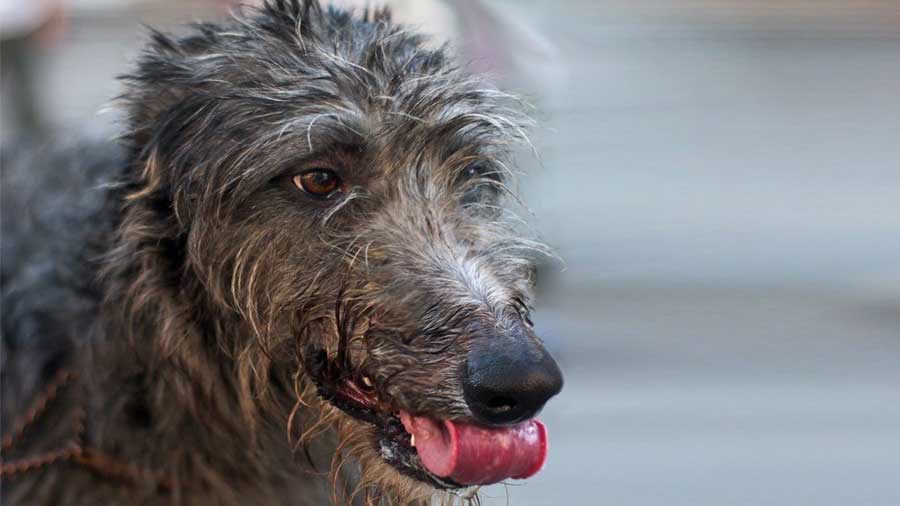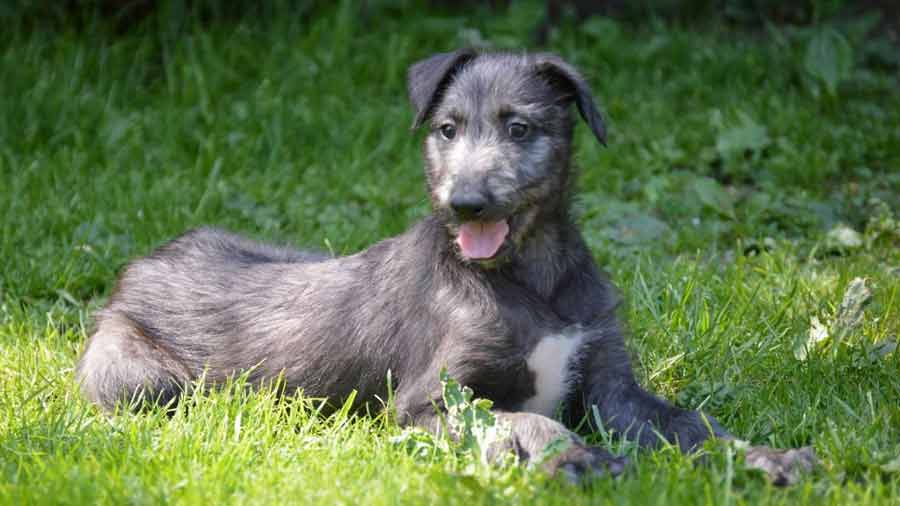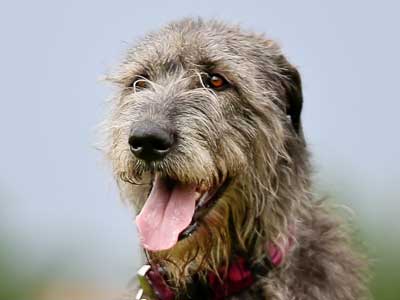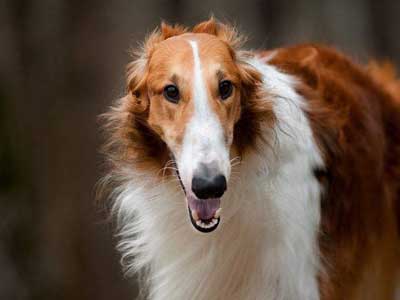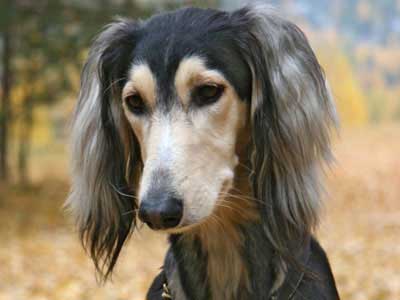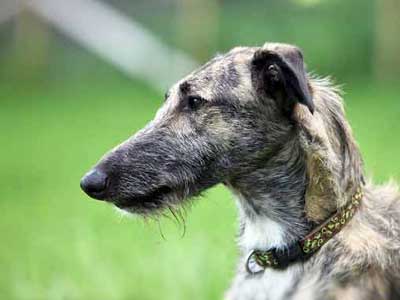Scottish Deerhound
Breed Information |
|
|---|---|
| Popularity |
2022: #155 2021: #158 2020: #166 2019: #149 2018: #158 2017: #168 2016: #154 2015: #152 |
| Name | Scottish Deerhound |
| Other names | Deerhound |
| Origin |  United Kingdom United Kingdom |
| Breed Group |
Hound (AKC:1886) Sighthounds & Pariahs (UKC) |
| Size | Giant |
| Type | Purebred |
| Life span | 8-10 years |
| Temperament |
Dignified Docile Friendly Gentle Polite Quietly |
| Height | 28-32 inches (71-81 cm) |
| Weight | 75-110 pounds (34-50 kg) |
| Colors |
Blue Gray Brindle Gray Gray Brindle Blue |
| Litter Size | 4-8 puppies |
| Puppy Prices |
Average $1000 - $2500 USD Today the Scottish Deerhound is still a fairly uncommon breed. In general, the average cost to get the Scottish Deerhound puppy is approximately $1,000 to $2,500. The cost of purchasing a Scottish Deerhound depends on factors like the breeders' location, character, litter size, pedigree, breed popularity, and socialization efforts. |
Breed Characteristics |
|
|---|---|
| Adaptability |
3 stars |
| Apartment Friendly |
4 stars Scottish Deerhounds can do okay in an in apartment if they are sufficiently exercised. They are relatively inactive indoors. If they are taken for walks they can live without a yard, but they do best with a large, fenced yard. |
| Barking Tendencies |
1 stars Rare |
| Cat Friendly |
2 stars |
| Child Friendly |
5 stars Good with Kids: This is a suitable dog breed for kids. It is also friendly toward other pets and friendly toward strangers. |
| Dog Friendly |
5 stars |
| Exercise Needs |
3 stars This is a very active breed that needs to be taken on a daily, long walk or jog, making an excellent jogging companion. Always keep in mind that they have an instinct to chase. Do not let them off lead in an unsafe area. |
| Grooming |
2 stars The Deerhound’s harsh coat is usually easy to care for, but some Deerhounds have a silkier, longer coat that can become quite tangled. Usually, though, all he needs is a good brushing with a pin brush or slicker brush two or three times a week. Give the coat a going over with a stainless steel Greyhound comb to make sure you didn’t miss any tangles and to comb out the hair on the face (known as furnishings) and you’re done. Only a few baths a year, when the dog is dirty, are necessary. |
| Health Issues |
5 stars Hypoallergenic: NoProne to hip dysplasia, epilepsy and eye problems. |
| Intelligence |
4 stars Ranking: #47 Full Ranking List |
| Playfulness |
3 stars |
| Shedding Level |
3 stars Moderate Shedding: Expect this dog to shed regularly. Be prepared to vacuum often. Brushing will reduce shedding as well as make the coat softer and cleaner. |
| Stranger Friendly |
5 stars |
| Trainability |
4 stars Moderately Easy Training: The Scottish Deerhound is eager to please and typically easy to train. The Scottish Deerhound requires a firm and consistent pack leader that is able to exert their authority, otherwise, it is not uncommon for the dog to become stubborn and unwilling to listen. |
| Watchdog Ability |
1 stars Low Watchdog Ability: This dog will not likely bark and alert its owners when an intruder is present. If a situation escalates, the dog should not be depended on to defend and protect its owner and family. |
Scottish Deerhound Names |
||
|---|---|---|
| Rank | Boy Names | Girl Names |
| 01 | Buddy | Bella |
| 02 | Charlie | Lucy |
| 03 | Toby | Bailey |
| 04 | Tucker | Coco |
| 05 | Bear | Maggie |
| 06 | Oliver | Penny |
| 07 | Buster | Lily |
| 08 | Zeus | Nala |
| 09 | Lucky | Zoey |
| 10 | Leo | Gracie |
| 100 Cute Puppy Names › | ||
Overview |
|---|
|
The Scottish Deerhound has a body like that of a greyhound but is of larger size and bone, enabling it to run at great speed using the double-suspension gallop without sacrificing strength and endurance. Its trotting gait is easy and true. Its hair is harsh and crisp, about 3 to 4 inches long on the body, ideally close-lying. Such a coat imparts a weather- (and dirt-) resistant quality, an essential asset in cold, damp climates. The Scottish deerhound is mellow, low-key and easygoing — a gracious and well-mannered addition to the home. Outdoors, it loves to run and chase anything that moves. Indoors, it needs plenty of room to stretch on a soft surface. The deerhound is independent but willing to please; it is extremely sensitive. It is amiable toward, but often reserved with, strangers. This breed is good with children, other dogs and usually other pets, although it may give chase to strange animals. |
History |
|
The Scottish Deerhound has been in existence since before history was recorded. There are examples of hounds resembling the Scottish Deerhound dating back to the 1st century AD. The Scottish Deerhound is also commonly referred to as simply Deerhound. The Scottish Deerhound is a hunting breed that was utilized for hunting red deer through coursing and were kept primarily by nobility. Coursing deer is an old hunting technique that is rarely used today. This technique involved bringing the dog as close to the deer as possible and then releasing the dog to run down its prey. The Scottish Deerhound is a large boned and very fast breed, there were rarely sustained chases when coursing. The chase would typically be over within a few minutes. The Scottish Deerhound is very similar to the Greyhound as well as the Irish Wolfhound. The Scottish Deerhound was a primary contributor to the revival of the Irish Wolfhound in the 19th century. The Scottish Deerhound's hunting necessity became less and less prominent with the invention of the gun. Hunters required only a tracking dog to find the wounded animal and so the Scottish Deerhound was transitioned to a show breed kept only by breed enthusiasts. |
References
- [1] ^ YouTube: Scottish Deerhound - TOP 10 Interesting Facts
- [2] ^ FCI: DEERHOUND Breed Standard
